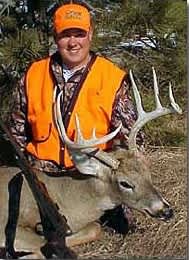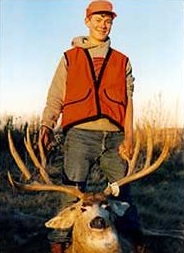Matt Highby on Spotting and Stalking Trophy Bucks
Cabela's 11.29.11

Matt Highby, Cabela’s Internet Purchasing Specialist, knows a thing or two about bagging trophy whitetails and mule deer. A peek into his trophy room is evidence of that. One whole wall is adorned with shoulder mounts of whitetails and mule deer that would make anyone salivate. While harvesting any trophy deer is an impressive accomplishment, what is truly astounding is that the vast majority of his have been shot on public land that receives a large amount of pressure each year. His “secret” is spotting and stalking far from the crowds. Few hunters consistently have much success spotting and stalking but at last count, Matt has duped over 14 whitetails between 130 and 150 class and a half dozen mule deer, with one bruiser that spanned 33 inches and netted 193 inches.
Spotting and stalking at first seems like a simple concept, but in actuality it is a bit more complex than grabbing a set of bino’s and heading afield. It involves planning, preparation and proper execution to be truly effective. A lot can be learned by listening to him recount last year’s trophy tale.
“Last season I was hunting a heavily used public piece of Sandhill country in the central part of Nebraska. Since there was quite a bit of pressure, I like to get as far away from the road as possible. Before I start hiking into a remote stretch of country, I like to find the deer first. The key is to find the highest vantage point that offers the best visibility around. Luckily, there was one such hill relatively close to the road. As the sun broke over the eastern horizon, I climbed the final few feet to the top of the windswept hill.
I set up my spotting scope and started glassing. When I glass, I like to seriously glass – the more land I can cover with my eyes the less I have to needlessly walk.
The biggest mistake most guys make when “glassing” is that they scan a hillside once with a set of binoculars and then move on. True glassing is about “setting up shop” and making a day of it. I use a solid tripod and a good spotting scope. I am confident in the area I have selected and I stay until I find the deer. You may glass an hour or two before seeing anything, then all of the sudden – Wham! A bedded deer just pops out at you that you have probably looked over 100 times.
On this particular morning, I glassed until about nine o’clock until I saw a good buck. He was bedded on a tall hill a couple of miles away. From his position, he could survey all of the surrounding area for approaching danger. After watching for several minutes, he suddenly got up, looked around and ran down the hill into a small valley. He quickly chomped several mouthfuls of grass, and ran back up the hill and bedded down in the exact same spot. Every fifteen minutes or so, he would repeat the performance. You always hear about those cagey old bucks, this was one of them. All deer are pretty wary, but this one knew that it was unsafe to leave his hill top sanctuary and feed for more than a few minutes at a time.
 After watching him run down the hill a few times, I realized that when he was on his way down there was a window of opportunity when his vision was obstructed by other low lying hills. After I determined the buck was large enough to go after, I waited until he disappeared into the valley then crawled off my perch and out of his sight. Since the wind was quartering towards him, I had to circle all the way around the offside of his hill before I could start stalking him.
After watching him run down the hill a few times, I realized that when he was on his way down there was a window of opportunity when his vision was obstructed by other low lying hills. After I determined the buck was large enough to go after, I waited until he disappeared into the valley then crawled off my perch and out of his sight. Since the wind was quartering towards him, I had to circle all the way around the offside of his hill before I could start stalking him.
For over six hours I stalked him, only chancing to move when he was out of sight. By three o’clock that afternoon I was in position for a shot. The buck was still in the same bed, now about 100 yards away. Lying prone, I slowly pushed my gun through two clumps of yucca bush and steadied myself for the shot. As the trigger broke, instead of the deafening boom all that was heard was a high pitched grating of fingernails on a chalk board and a loud “clunk” I looked down and realized from all the crawling to get in position, the open action of the inline muzzleloader had become full of fine sand. The buck was now aware that something was wrong and was standing up, looking at me. The game was almost up and I had a gun that would not fire! I quietly blew the sand out, being extra careful not to spook the already alarmed buck even more. Deciding it was now or never, I pulled back the bolt handle, and it was immediately evident by the loud scratching noise that I hadn’t got all of the sand out. I only had a couple of seconds until the buck split so I decided to try the shot again.
With a cloud of white smoke and loud “Boooomm” the muzzleloader fired and when the smoke cleared, he was lying on his back with his antlers stuck into the soft sand. The hunt had ended and now the work had begun. Before I started dragging the buck back to civilization, I took a minute to look at this deer. His heavy, tall rack appeared to be in the mid 140’s but what was more impressive was the cunning he displayed. I knew a buck of this caliber, taken on public land was something to be proud of.
Getting a large bodied buck out of the backcountry can be either relatively easy or an absolute nightmare, depending upon how well you are prepared. If you can bone out meat in the field, this is often the best option. Given the choice I like to carry a packframe with a large cargo compartment. An entire deer can usually be boned out and stowed inside the bag and be carried out in one trip. However, In Nebraska, it is not legal to bone out, or even quarter deer in the field, so I always have a Deer Drag rolled up and strapped to my daypack. While dragging a buck several miles is not the most enjoyable proposition, it is manageable. Four hours after I pulled the trigger, I had my deer back to the truck.
Backcountry deer hunting can be a lot of work, and it may not be for everyone, but if you are limited to hunting public land and want to hang your tag on a bruiser, follow the techniques of Matt Highby and go where few others will follow.
Start every deer season at Cabela’s.

